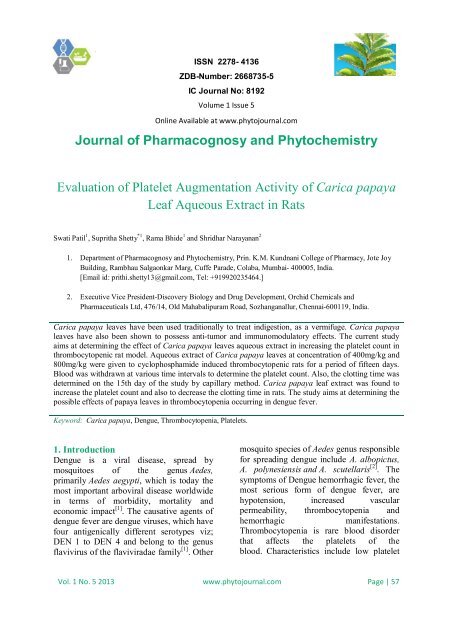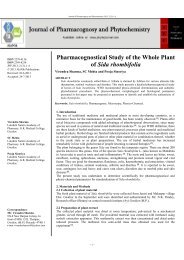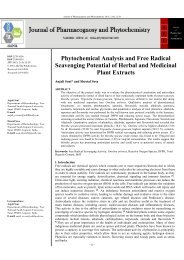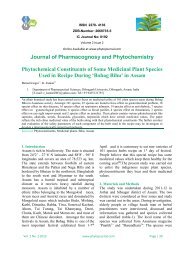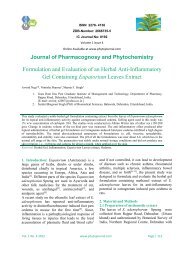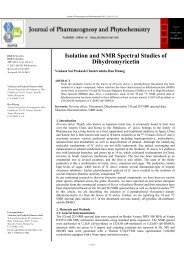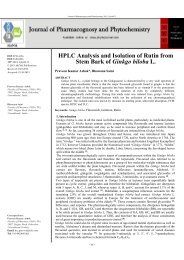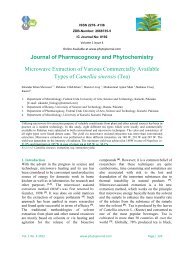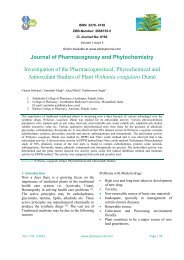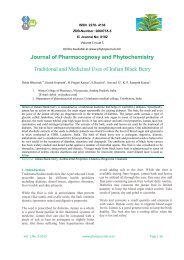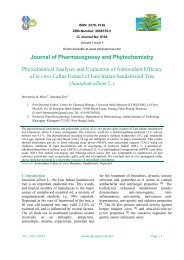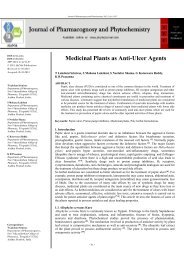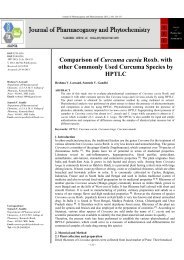Carica papaya - Journal of Pharmacognosy and Phytochemistry
Carica papaya - Journal of Pharmacognosy and Phytochemistry
Carica papaya - Journal of Pharmacognosy and Phytochemistry
Create successful ePaper yourself
Turn your PDF publications into a flip-book with our unique Google optimized e-Paper software.
ISSN 2278- 4136<br />
ZDB-Number: 2668735-5<br />
IC <strong>Journal</strong> No: 8192<br />
Volume 1 Issue 5<br />
Online Available at www.phytojournal.com<br />
<strong>Journal</strong> <strong>of</strong> <strong>Pharmacognosy</strong> <strong>and</strong> <strong>Phytochemistry</strong><br />
Evaluation <strong>of</strong> Platelet Augmentation Activity <strong>of</strong> <strong>Carica</strong> <strong>papaya</strong><br />
Leaf Aqueous Extract in Rats<br />
Swati Patil 1 , Supritha Shetty *1 , Rama Bhide 1 <strong>and</strong> Shridhar Narayanan 2<br />
1. Department <strong>of</strong> <strong>Pharmacognosy</strong> <strong>and</strong> <strong>Phytochemistry</strong>, Prin. K.M. Kundnani College <strong>of</strong> Pharmacy, Jote Joy<br />
Building, Rambhau Salgaonkar Marg, Cuffe Parade, Colaba, Mumbai- 400005, India.<br />
[Email id: prithi.shetty13@gmail.com, Tel: +919920235464.]<br />
2. Executive Vice President-Discovery Biology <strong>and</strong> Drug Development, Orchid Chemicals <strong>and</strong><br />
Pharmaceuticals Ltd, 476/14, Old Mahabalipuram Road, Sozhanganallur, Chennai-600119, India.<br />
<strong>Carica</strong> <strong>papaya</strong> leaves have been used traditionally to treat indigestion, as a vermifuge. <strong>Carica</strong> <strong>papaya</strong><br />
leaves have also been shown to possess anti-tumor <strong>and</strong> immunomodulatory effects. The current study<br />
aims at determining the effect <strong>of</strong> <strong>Carica</strong> <strong>papaya</strong> leaves aqueous extract in increasing the platelet count in<br />
thrombocytopenic rat model. Aqueous extract <strong>of</strong> <strong>Carica</strong> <strong>papaya</strong> leaves at concentration <strong>of</strong> 400mg/kg <strong>and</strong><br />
800mg/kg were given to cyclophosphamide induced thrombocytopenic rats for a period <strong>of</strong> fifteen days.<br />
Blood was withdrawn at various time intervals to determine the platelet count. Also, the clotting time was<br />
determined on the 15th day <strong>of</strong> the study by capillary method. <strong>Carica</strong> <strong>papaya</strong> leaf extract was found to<br />
increase the platelet count <strong>and</strong> also to decrease the clotting time in rats. The study aims at determining the<br />
possible effects <strong>of</strong> <strong>papaya</strong> leaves in thrombocytopenia occurring in dengue fever.<br />
Keyword: <strong>Carica</strong> <strong>papaya</strong>, Dengue, Thrombocytopenia, Platelets.<br />
1. Introduction<br />
Dengue is a viral disease, spread by<br />
mosquitoes <strong>of</strong> the genus Aedes,<br />
primarily Aedes aegypti, which is today the<br />
most important arboviral disease worldwide<br />
in terms <strong>of</strong> morbidity, mortality <strong>and</strong><br />
economic impact [1] . The causative agents <strong>of</strong><br />
dengue fever are dengue viruses, which have<br />
four antigenically different serotypes viz;<br />
DEN 1 to DEN 4 <strong>and</strong> belong to the genus<br />
flavivirus <strong>of</strong> the flaviviradae family [1] . Other<br />
mosquito species <strong>of</strong> Aedes genus responsible<br />
for spreading dengue include A. albopictus,<br />
A. polynesiensis <strong>and</strong> A. scutellaris [2] . The<br />
symptoms <strong>of</strong> Dengue hemorrhagic fever, the<br />
most serious form <strong>of</strong> dengue fever, are<br />
hypotension, increased vascular<br />
permeability, thrombocytopenia <strong>and</strong><br />
hemorrhagic<br />
manifestations.<br />
Thrombocytopenia is rare blood disorder<br />
that affects the platelets <strong>of</strong> the<br />
blood. Characteristics include low platelet<br />
Vol. 1 No. 5 2013 www.phytojournal.com Page | 57
<strong>Journal</strong> <strong>of</strong> <strong>Pharmacognosy</strong> <strong>and</strong> <strong>Phytochemistry</strong><br />
count (100000 cells per mm [3] <strong>of</strong> blood or<br />
less) <strong>and</strong> low platelet survival time. Other<br />
symptoms include a tendency to bleed<br />
excessively into mucous membranes,<br />
especially during menstruation [3] . Recently,<br />
<strong>Carica</strong> <strong>papaya</strong> leaves have been<br />
successfully employed in folk medicine for<br />
the treatment <strong>of</strong> dengue infections with<br />
haemorrhagic manifestations, using<br />
suspensions <strong>of</strong> powdered leaves in palm oil.<br />
<strong>Carica</strong> <strong>papaya</strong> L. belongs to the plant<br />
family <strong>Carica</strong>ceae. A lot <strong>of</strong> work has been<br />
carried out on plant parts like fruits, seeds<br />
<strong>and</strong> roots, indicating the presence <strong>of</strong><br />
biologically active compounds [4] .<br />
Cyclophosphamide is a synthetic alkylating<br />
agent been used for its antineoplastic <strong>and</strong><br />
immunosuppressive activities, <strong>and</strong> was<br />
introduced as an antitumour agent in 1958.<br />
Cyclophosphamide was used as toxicant in<br />
the current study because <strong>of</strong> its capacity to<br />
induce stable thrombocytopenia[ 5] .<br />
In the current study, the ability <strong>of</strong> <strong>Carica</strong><br />
<strong>papaya</strong> leaf aqueous extract in increasing<br />
the platelet count in cyclophosphamide<br />
induced thrombocytopenic rat model was<br />
evaluated.<br />
2. Materials <strong>and</strong> Methods:<br />
2.1 Plant material<br />
<strong>Carica</strong> <strong>papaya</strong> leaf aqueous extract was<br />
obtained by sonication the powdered leaf<br />
material in water at 37° C.<br />
2.2 Animals<br />
Albino Wistar rats (100-125g) <strong>of</strong> either sex<br />
were used for the study. They were housed<br />
under st<strong>and</strong>ard conditions <strong>of</strong> temperature<br />
<strong>and</strong> light <strong>and</strong> fed with st<strong>and</strong>ard diet <strong>and</strong><br />
water ad libitum. Experimental protocol was<br />
approved by Institutional Animal Ethics<br />
Committee.<br />
2.3 Platelet augmentation activity<br />
The rats were divided into four groups <strong>of</strong> six<br />
animals each: Group I was treated with<br />
saline (10ml/kg p.o) for a period <strong>of</strong> fifteen<br />
days; Group II served as toxicant group <strong>and</strong><br />
was given cyclophosphamide (50mg/kg s.c)<br />
for three consecutive days; Group III was<br />
treated with <strong>Carica</strong> <strong>papaya</strong> leaf aqueous<br />
extract(400 mg/kg p.o) for a period <strong>of</strong><br />
fifteen days along with cyclophosphamide<br />
(50mg/kg s.c) for first three days; Group IV<br />
was treated with <strong>Carica</strong> <strong>papaya</strong> leaf<br />
aqueous extract(800 mg/kg p.o) for a period<br />
<strong>of</strong> fifteen days along with<br />
cyclophosphamide(50mg/kg s.c) for first<br />
three days.<br />
Blood was withdrawn from retro-orbital<br />
plexus on the 1 st , 4 th , 7 th <strong>and</strong> 11 th day <strong>of</strong><br />
study after subjecting the animals to light<br />
anesthesia using ether <strong>and</strong> platelet count was<br />
determined by using automated cell counter<br />
Coulter Act-Diff [6] (Patrick <strong>and</strong> Singh,<br />
2011). On the 15 th day, the clotting time <strong>of</strong><br />
blood was determined by capillary method.<br />
3. Results:<br />
3.1 Platelet count:<br />
<strong>Carica</strong> <strong>papaya</strong> leaf aqueous extract at<br />
concentrations <strong>of</strong> 400mg/kg <strong>and</strong> 800mg/kg<br />
were found to significantly increase the<br />
platelet count in cyclophosphamide induced<br />
rat model.<br />
3.2 Clotting time: The clotting time <strong>of</strong> the<br />
treatment group were found to be<br />
considerably lower than that <strong>of</strong> toxicant<br />
group.<br />
3.3 Statistical Analysis:<br />
Values are mean ± SEM. One-way ANOVA<br />
followed by Tukey-Kramer posttest was<br />
applied for statistical analysis <strong>and</strong> the level<br />
<strong>of</strong> significance was set at p ≤ 0.05.<br />
Vol. 1 No. 5 2013 www.phytojournal.com Page | 58
<strong>Journal</strong> <strong>of</strong> <strong>Pharmacognosy</strong> <strong>and</strong> <strong>Phytochemistry</strong><br />
Table 1. Effect <strong>of</strong> C. <strong>papaya</strong> leaf aqueous extract on platelet count in rats<br />
Treatment group <strong>and</strong> dose (mg/kg)<br />
Normal Control<br />
Toxicant control<br />
(cyclophosphamide) (50mg/kg)<br />
<strong>Carica</strong> <strong>papaya</strong> aqueous extract<br />
(400mg/kg)<br />
<strong>Carica</strong> <strong>papaya</strong> aqueous extract<br />
(800mg/kg)<br />
Mean Platelet count (cells per cubic mm)<br />
Time interval in days<br />
1 4 7 11<br />
713000 ± 746000 ±<br />
719167 ±<br />
722667 ± 17701<br />
19183<br />
12359<br />
22773<br />
705667 ± 608833 ±<br />
164500 ±<br />
555167 ± 33787<br />
70610<br />
39661<br />
13304<br />
745333 ± 721500 ±<br />
36741<br />
33272 c 633000 ± 26865 556833 ±<br />
30414 a<br />
894833 ± 837333 ± 1084000 ± 831000 ±<br />
26368 c 19249 a 29871 a 16118 a<br />
P values: a < 0.001, b < 0.01, c < 0.05 when Experimental groups compared with Toxicant control<br />
Table 2. Effect <strong>of</strong> C. <strong>papaya</strong> leaf aqueous extract on clotting time in rats<br />
Groups<br />
Time (in<br />
secs)<br />
Normal<br />
Control<br />
Toxicant control<br />
(cyclophosphamide)<br />
(50mg/kg)<br />
Mean clotting time (sec.) on day 15<br />
<strong>Carica</strong> <strong>papaya</strong> aqueous<br />
extract (400mg/kg)<br />
97.5 ±<br />
2.725 158 ± 7.073 129 ± 3.124 a 107 ± 2.06 a<br />
<strong>Carica</strong> <strong>papaya</strong> aqueous<br />
extract (800mg/kg)<br />
P values: a < 0.001, b < 0.01, c < 0.05 when Experimental groups compared with Toxicant control<br />
4. Discussion:<br />
Dengue virus, the main cause <strong>of</strong> dengue<br />
fever induces bone marrow suppression.<br />
Since bone marrow is the manufacturing<br />
center <strong>of</strong> blood cells, its suppression causes<br />
deficiency <strong>of</strong> blood cells leading to low<br />
platelet count. Anaemia <strong>and</strong> spontaneous<br />
severe bleeding are the other consequences<br />
<strong>of</strong> bone marrow suppression. Dengue virus<br />
can bind to human platelets in presence <strong>of</strong><br />
virus specific antibody <strong>and</strong> cause immune<br />
mediated clearance <strong>of</strong> platelets [7] .<br />
Spontaneous aggregation <strong>of</strong> platelets to<br />
vascular endothelial cell pre-infected by<br />
virus induces aggregation, lysis <strong>and</strong> platelet<br />
destruction. Anti-platelet antibodies<br />
generated after dengue virus infection<br />
causes destruction <strong>of</strong> platelets. Moreover,<br />
dengue virus causes platelet reduction <strong>and</strong><br />
vascular alteration which is the principal<br />
factor causing haemorrhagic problems [8] .<br />
Vinca-alkaloids have been proven effective<br />
against anti-platelet macrophages in patients<br />
suffering from Idiopathic Thrombocytopenic<br />
Purpura (ITP) [9] . The saponins in Panax<br />
notoginseng have been shown to reduce<br />
platlet adhesion <strong>and</strong> aggregation, prevent<br />
thrombosis <strong>and</strong> improve microcirculation [7] .<br />
<strong>Carica</strong> <strong>papaya</strong> leaves contain various<br />
phytoconstituents like saponins, tannins,<br />
cardiac glycosides <strong>and</strong> alkaloids. The<br />
Vol. 1 No. 5 2013 www.phytojournal.com Page | 59
<strong>Journal</strong> <strong>of</strong> <strong>Pharmacognosy</strong> <strong>and</strong> <strong>Phytochemistry</strong><br />
alkaloids present include carpaine,<br />
pseudocarpaine <strong>and</strong> dehydrocarpaine I <strong>and</strong><br />
II. These constituents can act on the bone<br />
marrow, prevent its destruction <strong>and</strong> enhance<br />
its ability to produce platelets. Moreover, it<br />
can also prevent platelet destruction in the<br />
blood <strong>and</strong> thereby increase the life <strong>of</strong> the<br />
platelet in circulation.<br />
5. References:<br />
1. Gubler J, Dengue <strong>and</strong> Dengue<br />
Hemorrhagic Fever. ClinMicrobiol Rev<br />
1998; 11(3):480–496.<br />
2. 2. Chan Y, Ho B, Chan K, Aedes<br />
aegypti (L.) <strong>and</strong> Aedes albopictus (Skuse)<br />
in Singapore City. Bull World Health<br />
Organ 1971; 44(5):651-657.<br />
3. Shirtcliffe P, Cameron E, Nicholson K,<br />
Wiselka M, Don't forget dengue! Clinical<br />
features <strong>of</strong> dengue fever in returning<br />
travellers. J R Coll Physicians Lond 1998;<br />
32(3):235-7.<br />
4. Sathasivam K, Ramanathan S, Mansor S,<br />
Haris M, Wernsdorfer W, Thrombocyte<br />
count in mice after administration <strong>of</strong><br />
<strong>papaya</strong> leaf suspension. The Middle<br />
European <strong>Journal</strong> <strong>of</strong> Medicine 2009;<br />
121(3):19-22.<br />
5. Hong N, Kong-yan L, Xiao-qi Z, Xue-ying F,<br />
Duan-rong Y, Yu-si W, Jiu-yao Z, Wen-cai<br />
Y,Establishment <strong>of</strong> a Mouse<br />
Thrombocytopenia Model Induced by<br />
Cyclophosphamide. Zoological research<br />
2009; 30(6):645-652.<br />
6. Patrick J, Singh Y, Micromeritics. In<br />
Martin’s physical pharmacy <strong>and</strong><br />
pharmaceutical sciences 2009; 6:452-254.<br />
Wolters Kluwer India Pvt Ltd.<br />
7. Wang J, Xu J, Zhong J, Effect <strong>of</strong> Radix<br />
notoginsengsaponins on platelet<br />
activating molecule expression <strong>and</strong><br />
aggregation in patient with blood<br />
hyperviscosity syndrome. ZhingguoZhong<br />
XI Yi Jie He ZaZhi 2004; 24(4):312-316.<br />
8. Krishnamurti C, Peat R, Cutting M,<br />
Rothwell S, Platelet adhesion to Dengue-2<br />
virus infected cell. American <strong>Journal</strong> <strong>of</strong><br />
Tropical medicine 2002; 66(4):435-441.<br />
9. Ahn Y, Bymes J, Harrington W, Cayer M,<br />
Smith D, Brunskill D, Pall M, The<br />
treatment <strong>of</strong> idiopathic thrombocytopenia<br />
with Vinblastine-loaded platelets. N Engl J<br />
Med 1998; 298(20):1101-1107.<br />
Vol. 1 No. 5 2013 www.phytojournal.com Page | 60


